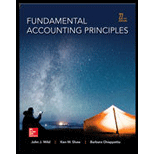
Concept explainers
Concept Introduction:
Material Cost variance: The difference between the
• Actual price of the material varies from the standard price and/or
• Actual quantity of material used varies from the standard quantity.
Therefore, Material Cost Variance is the sum of (i) Material Price Variance and (ii) Material Quantity Variance.
Material Price Variance:The difference between the actual rate of materials and the standard rate of materials used in the production is the Material Price Variance.
Material Quantity Variance:The difference between actual quantity of material used and the standard quantity of material to be used is the material quantity variance.
The following formulas are used to calculate Material cost variance:
Material Cost Variance (MCV) = Material Price Variance (MPV) + Material Quantity Variance (MQV)
Also Material Cost Variance (MCV) = Standard Cost – Actual Cost
Material Price Variance (MPV) = Standard material cost for actual quantity – Actual material cost
Material Quantity Variance (MQV) = Standard cost of standard quantity of material – Standard cost of
actual quantity of material
Material Cost Variance gives a view of deviations from the set standards which can be wither favorable or unfavorable
To determine: The actual quantity of material used in production
Want to see the full answer?
Check out a sample textbook solution
Chapter 23 Solutions
Fundamental Accounting Principles -Hardcover
- Can you help me solve this general accounting problem using the correct accounting process?arrow_forwardV Industries has sales of $240,000 and the cost of goods available for sale of $198,000. If the gross profit rate is 32.75%, the estimated cost of the ending inventory under the gross profit method is? Help mearrow_forwardaccounting questionarrow_forward

 AccountingAccountingISBN:9781337272094Author:WARREN, Carl S., Reeve, James M., Duchac, Jonathan E.Publisher:Cengage Learning,
AccountingAccountingISBN:9781337272094Author:WARREN, Carl S., Reeve, James M., Duchac, Jonathan E.Publisher:Cengage Learning, Accounting Information SystemsAccountingISBN:9781337619202Author:Hall, James A.Publisher:Cengage Learning,
Accounting Information SystemsAccountingISBN:9781337619202Author:Hall, James A.Publisher:Cengage Learning, Horngren's Cost Accounting: A Managerial Emphasis...AccountingISBN:9780134475585Author:Srikant M. Datar, Madhav V. RajanPublisher:PEARSON
Horngren's Cost Accounting: A Managerial Emphasis...AccountingISBN:9780134475585Author:Srikant M. Datar, Madhav V. RajanPublisher:PEARSON Intermediate AccountingAccountingISBN:9781259722660Author:J. David Spiceland, Mark W. Nelson, Wayne M ThomasPublisher:McGraw-Hill Education
Intermediate AccountingAccountingISBN:9781259722660Author:J. David Spiceland, Mark W. Nelson, Wayne M ThomasPublisher:McGraw-Hill Education Financial and Managerial AccountingAccountingISBN:9781259726705Author:John J Wild, Ken W. Shaw, Barbara Chiappetta Fundamental Accounting PrinciplesPublisher:McGraw-Hill Education
Financial and Managerial AccountingAccountingISBN:9781259726705Author:John J Wild, Ken W. Shaw, Barbara Chiappetta Fundamental Accounting PrinciplesPublisher:McGraw-Hill Education





